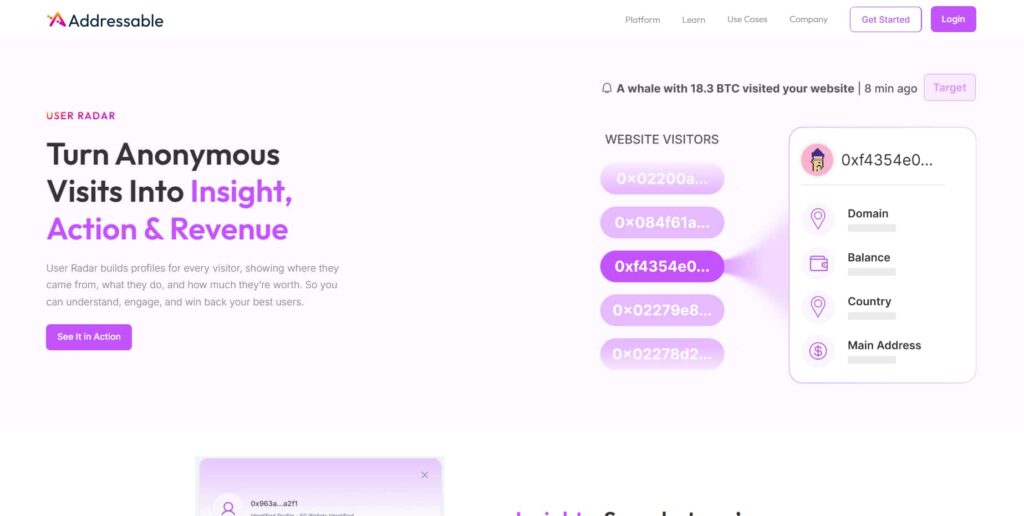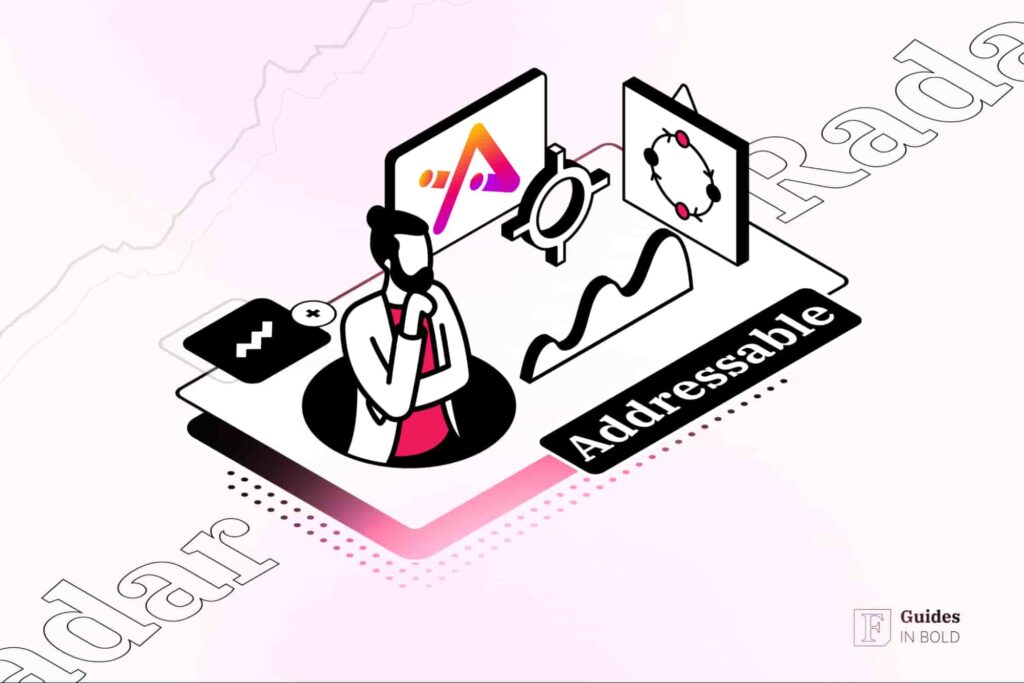When used to their full potential, customer relationship management (CRM) tools can help companies tailor their marketing campaigns for high-intent users and greatly boost revenue. Addressable’s latest solution, User Radar, does just that by combining both on- and off-chain analytics to transform anonymous website traffic into actionable leads.
What is User Radar?

User Radar homepage. Source: Addressable.io
The solution was developed by Addressable, a Web3 growth platform that fuses blockchain intelligence with social data to deliver targeted, programmatic ad campaigns. Combining on-chain conversion metrics and dynamic audience optimization, the platform seeks to address some shortcomings associated with traditional Web2 analytics, which ignore factors such as wallet activity and lack insight into broader user journey context.
More precisely, User Radar aggregates wallet balances across seven blockchains, tracks activity across all detected wallets, and supports multi-ad network retargeting. All of the data combined then allows businesses to re-engage users on platforms like X via more optimized campaigns on crypto-aware ad networks.
How does Web3 marketing work?
Traditional and Web3 marketing differ in a number of ways. For instance, traditional digital marketing focuses on search engine optimization (SEO), social media engagement, display ads, etc. While these strategies are still relevant and important for any aspiring business, Web3, on the other hand, opens up additional possibilities for brands to connect with their audiences and present their services to those not yet within the ecosystem.
That is, instead of relying on search engines and social media platforms alone, Web3 marketing ensures that content is distributed via decentralized channels as well, helping projects remain transparent while ensuring the audience is interacting with personalized content they wish to see.
To achieve this goal, Web3 marketing tools analyze decentralized applications (dApps), Web3 games, and smart contract activity to give businesses a clearer overview of user preferences and thus enable more precise targeting and impactful campaigns.
Other key performance metrics include transaction volume used to gauge campaign-driven activity, conversion rates necessary to measure how many users have interacted with the desired material, and other indicators like click-through rates, time on site, and social media interaction.
Optimizing customer growth
Also worth noting is that follower quality is as critical as follower quantity since an engaged audience is more likely to continue interacting with the content down the line.
Accordingly, metrics such as customer acquisition cost (CAC) are required to optimize customer growth efficiency, while customer lifetime value (LTV) helps businesses evaluate both short-term impact and sustained growth by measuring long-term revenue potential from each individual customer.
Web3 marketing plans also tend to include events such as:
- Digital collectibles distribution;
- Token-based loyalty programs and events;
- Airdrops.
Overall, Web3 marketing seeks to develop a sense of transparency and user participation, which, in turn, builds brand trust and loyalty.
How does User Radar work? Some key features
User Radar is built to help marketers come up with strategies described above. It gives the user an overview of each individual visitor, including information on where they came from, what they do, and what their potential moves might be when engaging with the user’s project or app, based on acquisition source, wallet activity, holdings, behavior patterns, and buying power.
With pre-built cohorts based on Web3 activity, which are continuously updated as behaviors change, User Radar enables precise retargeting with personalized ads and reach expansion to encompass similar target audiences instead of merely identifying and retaining users who appear ready to leave the network.
The key features of User Radar thus include:
- Automatic identification and profiling: User Radar allows users to automatically detect wallet-enabled visitors and generate their user profiles;
- On-chain intelligence: By combining on-site behavior data with public wallet transactions, token holdings, and social activity, User Radar fleshes out user profiles and provides users with additional information that can later be used to develop more targeted marketing strategies;
- High-value user segmentation: The dashboard enables users to highlight their most valuable audiences according to parameters such as their geographical location, wallet balance, and so forth;
- Retargeting: Retargeting strategies help deliver online ads to people who have already visited the website, thus incentivizing them to return.
Integrated with Addressable’s marketing toolkit, User Radar features can be accessed within a single dashboard.
Other Addressable features
A good marketing strategy relies on a diverse assortment of tools. Web3 marketing, for instance, relies on social media platforms like X to allow organic and paid promotion to reach broad or targeted audiences while using websites such as centralized (CEXs) or decentralized (DEXs) exchanges to deploy banner ads or sponsored token listings.
With that in mind, Addressable also comes with the following use cases:
- X (Twitter) campaigns;
- Display and banner ads;
- Reddit campaigns;
- Performance measuring;
- Mobile app promotion;
- Web3 retargeting.
In more detail, those imply:
1. X (Twitter) campaigns
Addressable offers a data management platform (DMP) powered by on-chain and off-chain intelligence designed to precisely target and re-target high-intent users on X. Users with restricted accounts can also contact Addressable and get assistance recovering their accounts.
2. Display and banner ads
With display and banner ads, clients can advertise their projects on the websites with the most appropriate traffic, as well as within mobile apps.
3. Reddit campaigns
Reddit campaigns can also help optimize cost per wallet (CPW) metrics by allowing clients to focus on wallet-ready users likely to engage with their content while browsing relevant subreddits.
4. Performance measuring
Addressable users can monitor everything from ads and landing pages to wallet connections, mobile app installs, and on-chain transactions on seven major blockchains. Marketers thus can identify which channels attract high-lifetime-value (LTV) users and “Whales” while gaining insight into wallet-connected visitors who don’t convert.
5. Mobile app promotions
When it comes to mobile apps, users can optimize their Web3 mobile applications with automated ad campaign enhancements designed to drive on-chain conversions. The goal is to increase the lifetime value of wallet owners and boost on-chain activity beyond traditional metrics like app installs and clicks.
Addressable also supports integration with leading mobile measurement partners (MMPs) such as AppsFlyer and Singular, covering analytics for over 77% of Web3 mobile applications.
6. Web3 retargeting
As already mentioned, with Addressable, users can target and re-engage wallet owners using both on-chain and off-chain activity. However, the platform also makes it possible to reconnect visitors who didn’t connect, users who connected but didn’t convert, and even competitor wallet holders likely to switch.
In addition, marketers can gain insight into visitors’ token holdings, transaction history, wallet providers, chain activity, and behavioral tags such as “staking,” “liquidity provider,” “developer,” etc, allowing for even more precise marketing.
Conclusion
As a Web3 CRM solution, User Radar enhances traditional marketing strategies by introducing them to decentralized technologies, such as blockchain analytics. By combining on- and off-chain data in this fashion, the tool empowers businesses not only to identify but also engage with their most valuable clients with more personalized promotional material.
The use cases on offer are varied, ranging from social media campaigns to performance measurement and mobile app promotion. With a variety of products unified within a single dashboard, User Radar has the potential to accommodate a wide variety of users, particularly those with a crypto-oriented user base.
Disclaimer: The content on this site should not be considered investment advice. Investing is speculative. When investing, your capital is at risk.
FAQs
What is User Radar?
User Radar is a Web3-powered customer relationship management (CRM) dashboard developed by Addressable. It helps marketing teams develop targeted marketing strategies by leveraging both on- and off-chain analytics.
What is Web3 marketing?
Web3 marketing refers to various marketing strategies that make use of decentralized technologies (e.g., blockchain) to create more transparent and interactive promotional material.
How does User Radar differ from traditional CRM tools?
Unlike traditional CRM systems that rely on Web2 data alone, User Radar also incorporates blockchain data such as wallet transactions and token holdings to create more detailed user profiles.
How does Addressable protect user data?
To protect user data, Addressable adheres to security standards such as General Data Protection Regulation (GDPR) and complies with System and Organization Controls 2 (SOC 2). In addition, the platform itself employs security measures such as data encryption and regular auditing.
Is User Radar free?
No, User Radar is not free. Potential users will have to book a demo if they wish to explore its features.




